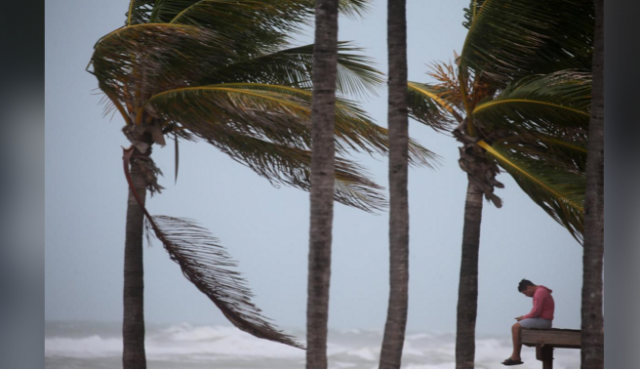
FORT MYERS, Florida – Hurricane Irma was set to make landfall in Florida on Sunday with devastating winds and life-threatening storm surges, prompting one of the largest evacuations in US history, after a destructive march up Cuba’s northern coast.
The storm was a Category 4 hurricane about 70 miles (115 km) south-southeast of Key West, Florida, as of 2 a.m. EDT (0600 GMT) on Sunday with maximum sustained winds of 130 mph (210 kph), the National Hurricane Center said. It was on a path that would take it along the state’s Gulf of Mexico coast near population centers including Tampa and St. Petersburg, it said.
Irma, which killed at least 22 people in the Caribbean, was considered a life-threatening danger to Florida as well, and could inflict a natural disaster causing billions of dollars in damage to the third-most-populous US state.
It was expected to rip through Florida’s southwestern archipelago on Sunday morning as a Category 4 storm, the second-highest designation on the Saffir-Simpson scale. Irma should then move inland over the Florida panhandle and southwestern Georgia on Monday afternoon, the NHC said.
Wind gusts near hurricane force began to batter the Florida Keys late on Saturday, the NHC said, with Key West seeing gusts of more than 80 mph. It has put out a hurricane watch and warning as well as a tropical storm warning for almost all of the state into Georgia and South Carolina – an area where about 20 million people live.
Storm surges pushed by a high tide were forecast to be as high as 15 feet (4.6 m) for low-lying area along the state’s west coast on Sunday, which could produce catastrophic flooding for thousands of homes.
The city of Miami imposed a curfew until 7 a.m. on Sunday and more than 260,000 customers in Florida were without power on Sunday morning, utilities reported.
“This is a life-threatening situation,” the center said.
Irma comes just days after Hurricane Harvey dumped record-setting rain in Texas, causing one of the costliest natural disasters in US history.
Tracking models showed Irma would make landfall on the Keys and head along Florida’s west coast, bringing 120 mph wind gusts to the state that is a major tourism hub, with an economy that comprises about 5 percent of U.S. gross domestic product.
More than 2,000 flights in and out of Florida were canceled on Saturday, according to tracking service FlightAware.com, and ground transport was scrambled by millions fleeing for safety.
Amid urgent warnings from state officials to evacuate before it was too late, downtown Miami was all but abandoned on Saturday.
Sheets of rain and wind gusts of more than 50 mph swept through the deserted city of 400,000 people several hours before expected landfall.
The wind sent a construction crane spinning on the roof of the Miami Worldcenter, a billion-dollar mixed-use project near the home of the Miami Heat basketball team and the city’s performing arts center.
On Florida’s west coast, resident Charley Ball said he expected a storm surge to completely engulf the island of Sanibel where he lives. “Just left the island and said goodbye to everything I own,” said Ball, 62.
MILLIONS FLEE
Irma was a Category 5 storm, the highest ranking possible, when it crashed into Cuba on Saturday morning.
It gradually weakened to Category 3 as it bumped along the island’s northern coastline, flooding streets and sending waves crashing over sea walls. But it gained strength over warm waters as it headed toward Florida, the NHC said.
Irma was forecast to dump up to 20 inches (50 cm) of rain over Florida and southeast Georgia through Monday, less than the 50 inches Hurricane Harvey dropped on parts of Texas and Louisiana two weeks ago, killing at least 60 people and causing an estimated $180 billion in property damage.
Irma could cause insurance losses of between $15 billion and $50 billion in the United States, catastrophe modeling firm AIR Worldwide said.
But unlike with Harvey, dangerous winds will barely abate once Irma makes landfall on Sunday morning.
In Cuba, the destruction along the north central coast was similar to that suffered by other Caribbean islands over the last week as Irma plowed into Ciego de Avila province.
People walked through ankle-deep water in Caibarien, a fishing town where streets were flooded and covered in seaweed. Elsewhere, winds toppled trees and utility polls or ripped apart roofs.
It was the first time the eye of a Category 5 storm had made landfall in Cuba since 1932, state media said, and the island’s Communist government ordered the evacuation of more than a million people from its path.
Officials in Florida have ordered a total of 6.3 million people, or about a third of the state’s population, to evacuate, creating massive traffic jams on highways and overcrowding shelters.
In Palm Beach, President Donald Trump’s waterfront Mar-a-Lago estate was under evacuation order.
“This is a storm of enormous destructive power, and I ask everyone in the storm’s path to heed ALL instructions from government officials,” Trump said on Twitter.
The window for people to leave evacuation zones was rapidly closing on Saturday, officials said, warning that gas stations would soon be without fuel and bridges would be closed in some areas.
Chris Cardona and his wife Laurie left their mobile home near Miami on Thursday to seek refuge with friends near Tampa.
“Not only did we go west, but so did Irma. She’s tracking us, that feisty minx,” Cardona, 54, said by phone.
For a graphic on Irma click HERE.









